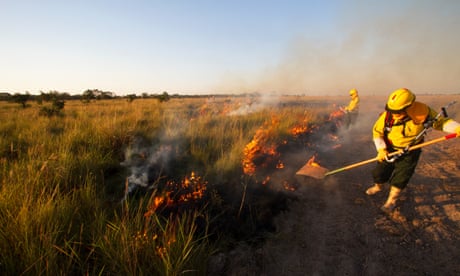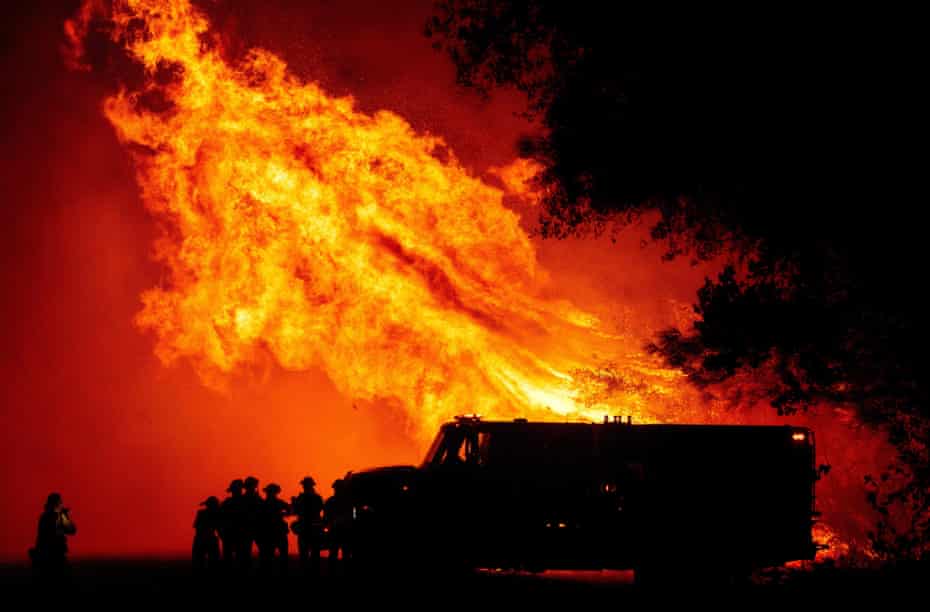Extract from The Guardian
Researchers call for new firefighting techniques that focus on managing landscapes, as global heating sees increase in blazes.
Flames tower over a fire engine in Oroville, California in 2020. Firefighters should be the last line of defence, say experts who want more funding for fire prevention.Last modified on Mon 25 Oct 2021 03.25 AEDT
A new approach is urgently needed to tackle global wildfires as current methods are no longer working, draining the public purse and placing lives at risk, according to experts.
This summer saw some of the worst wildfires in history and underscored the destructive impacts of global heating. As Cop26 approaches and is expected to shine a light on the importance of protecting ecosystems and building defences to avoid loss of homes and lives, experts say a lack of foresight and funding worldwide means harmful wildfires will continue to rage, putting communities and firefighters in danger.
Lenya Quinn-Davidson, a fire adviser at the University of California, said: “We’re seeing our historical approach to fighting fires is no longer working. We saw this summer in California that going out, attacking fires and putting them out was totally ineffective.”
In July, the Dixie fire in California spread to almost 1m acres (400,000 hectares). Bulldozers were used to dig fire breaks, but the flames spread regardless.
Guillermo Rein, professor of fire science at Imperial College London, said efforts to tackle wildfires wrongly focused on suppression techniques. Hundreds of firefighters spend weeks tackling blazes, with millions of pounds spent on equipment, including bulldozers, retardants, helicopters and airplanes.
“Fighting a fire with hundreds of people and tankers is the last thing we should be doing. It’s a desperate attempt when everything else has failed,” he said.
Babis Zaccharis, a Hellenic fire service volunteer in Greece, said: “Volunteers get paid nothing. The state provides those in the Greek fire service with some equipment but not everything that is needed, so I have bought my own. I’m happy to do this, but not everyone can. Unlike employed firefighters, our families get no compensation if we die in the line of duty.”
Rein said more fire brigades will be needed as wildfires continued to wreak havoc but many firefighters were struggling. “The risk of failure is horrible,” he said. “It’s not failing at your job, it’s failing to protect lives of your people and their property. It’s very stressful.”
“We need to take care of [firefighters] more – their health, their mental health. They need to be happy and in good shape because we will need them more,” he said.
This year, at least one volunteer firefighter died and two others were seriously injured tackling wildfires in Greece.
Wildfires also have an invisible but deadly impact on human health. Researchers have linked 33,510 deaths a year to wildfire pollution.
But, Rein said, firefighting should be the final line of defence against wildfires: “They are the last layer that protects us from a catastrophe.” Dealing with the growing threat of wildfires involves prioritising fire prevention and landscape management.

Not all wildfires are bad.
“Fire is a natural process and many landscapes around the world need fire,” said Cathelijne Stoof, an assistant professor specialising in wildfires at Wageningen University in the Netherlands. “Plants need fire to regenerate. Some need heat, some need smoke. A calm, mild fire can clear the forest understories underneath trees so when a big fire comes along, it doesn’t do as much damage to the ecosystem or people.”
Prescribed burns, intentional off-season fires that burn leaves and old wood and create breaks in the forest, can mitigate risk.
Stoof, along with Rein and Quinn-Davidson, has called for more funding for fire prevention and education into how to manage landscapes to prevent fire from getting out of control.
Quinn-Davidson said that despite some progress, such as a bill in California to provide insurance for people wanting to do this work, more was needed.
She said: “We need more people to make this work. We have a fraction of the people and resources we need to tackle this problem, not just for fighting fires but for doing all the work the rest of the year, such as prescribed burns and thinning [vegetation]. We need to hire and train more people, so we have a skilled workforce to do this work. That needs funding.”


No comments:
Post a Comment